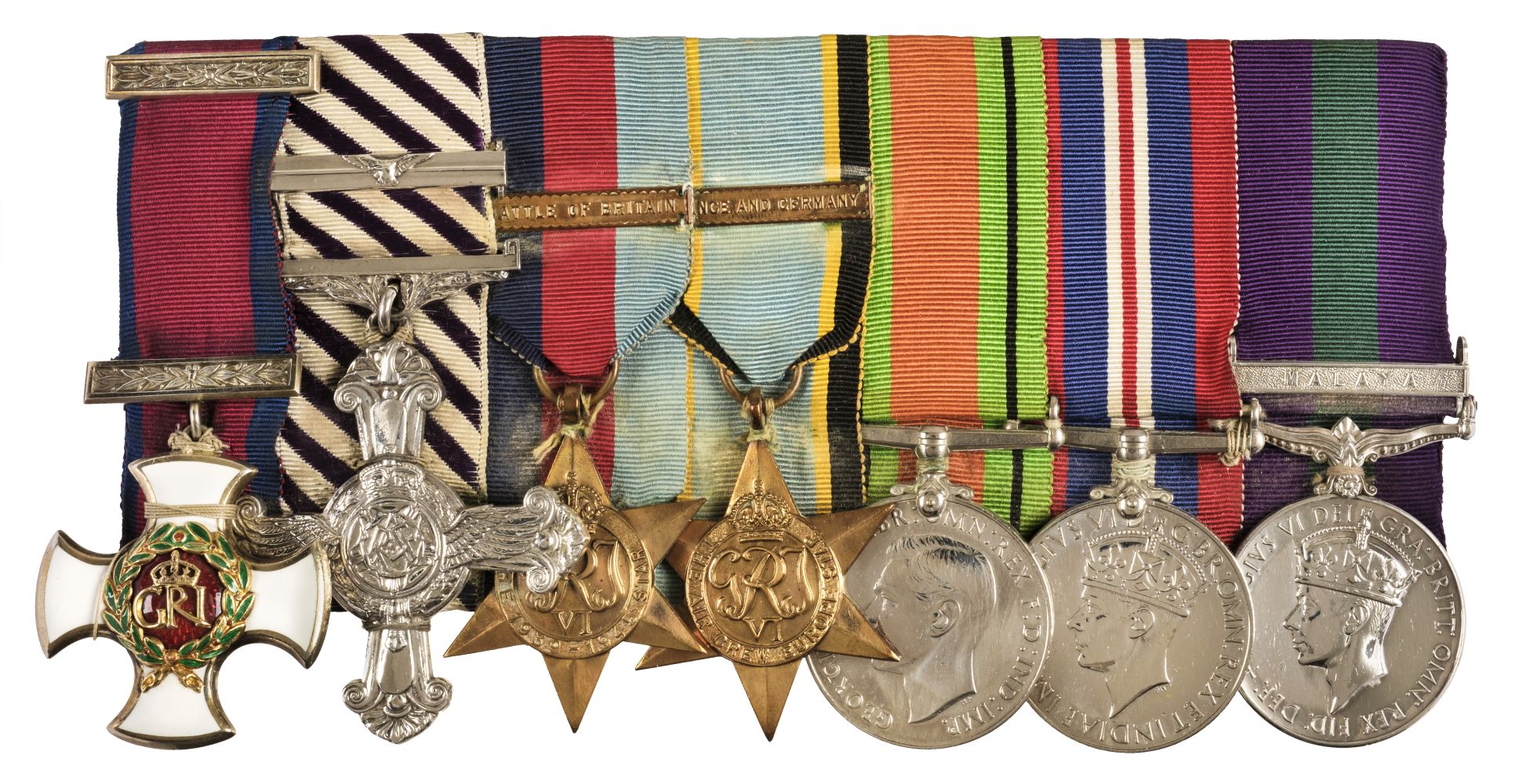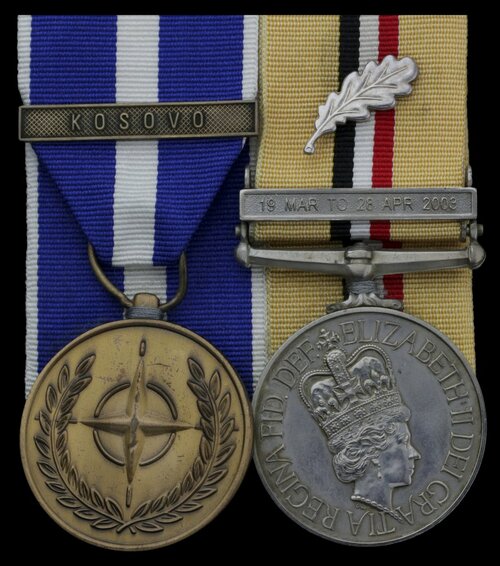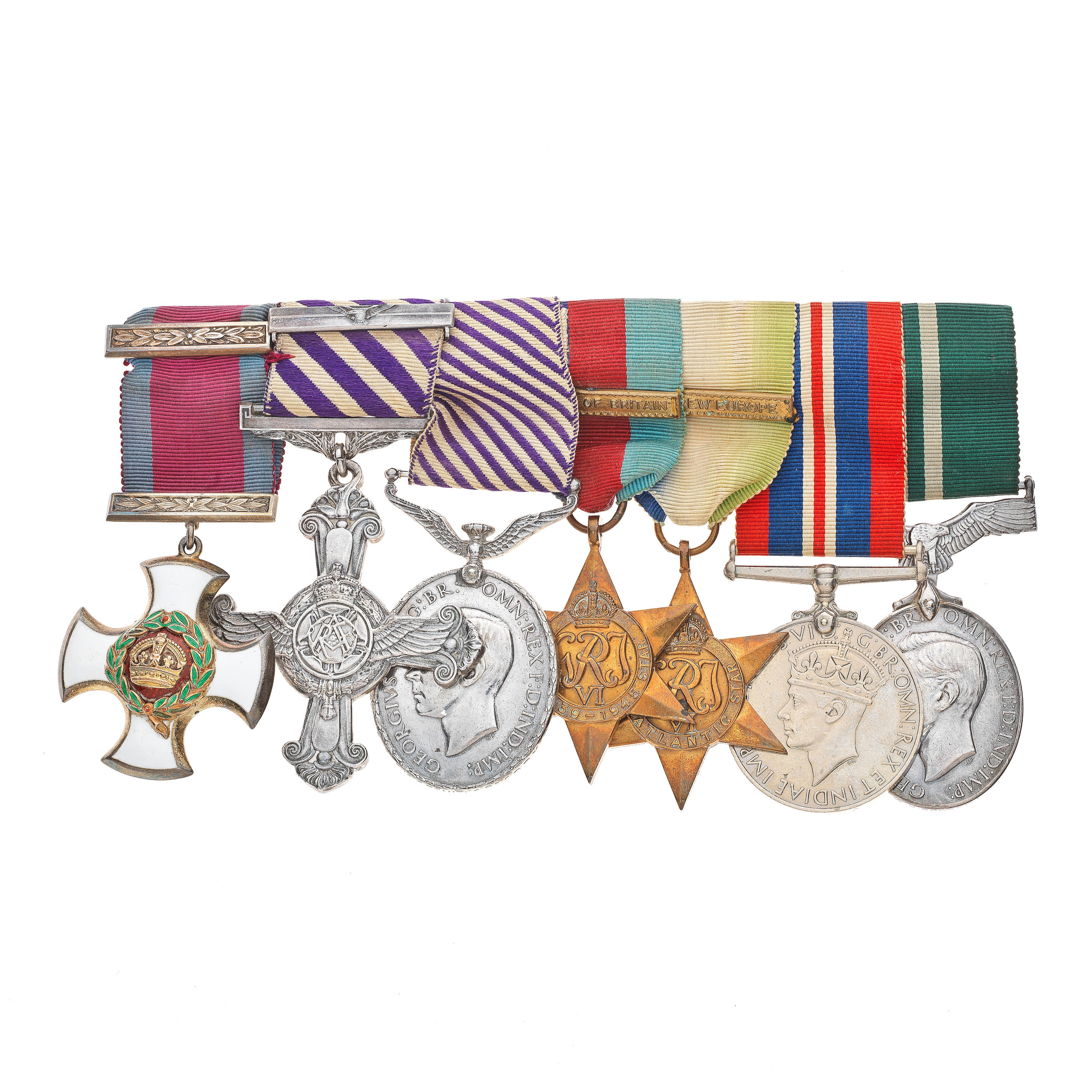An outstanding 'Battle of Britain' Squadron C.O.'s campaign group of three awarded to Squadron Leader H. M. Starr, Royal Air Force, who assumed command of No. 253 Squadron on 8 August 1940 - he flew his first sortie in Hurricanes from Kenley on 28 August and was engaged in a hot scrap over Redhill, taking a 20mm cannon shell to his engine which forced his withdrawal The very next day Starr 'lifted off' for the morning sortie and was shot down whilst engaging a large number of enemy aircraft who had their bombs set across sites in the southeast, he was shot down and forced to call upon his trusty parachute to save his life; floating over the 'Garden of England' it seems disgraceful that a trio of Me109's rounded on the helpless C.O. and machine-gunned him to death, leaving behind a heartbroken widow and an unborn child - this was just the second occasion such barbaric tactics had been employed by the enemy Such were the casualties during the Battle, command devolved upon one Squadron Leader T. P. 'Tom' Gleave for the second sortie of the day, who himself was shot down and badly burned; Gleave became the first Airman to go under the knife of Sir Archibald McIndoe and No. 253 was left with its third C.O. in less than 12 hours 1939-45 Star, clasp, Battle of Britain; Air Crew Europe Star; War Medal 1939-45 Star, nearly extremely fine (3) Harold Morley Starr was born at Swindon on 8 September 1941, the fifth of six children of Morley and Ellen Starr. Brought up in the Central Temperance Hotel where his mother was the proprietor, young Harold was educated at Clarence Street School and Cotham Grammar, Bristol. Having entered the Royal Air Force on a Scholarship in March 1934, he attended 5 Flying Training School, Sealand and consequently earned his 'wings'. He joined No.14 Squadron in March 1935 and was confirmed as Pilot Officer on 16 March. It was a little over a year before his first mishap in June 1936, while flying Audax K2028 with Airman 2nd Class T. W. McCarthy as his observer. Having the misfortune to suffer an engine failure, Starr used all his skill in bringing down the kite and 'narrowly missing a farmhouse, crashing in a field at South Marston'. While McCarthy walked away with a cut tongue, Starr suffered multiple serious injuries, including a fractured skull, leg and chest which kept him off duties until 28 June 1937. Having recovered in hospital he re-joined No. 59 Squadron at Old Sarum, before a number of postings to Hawkinge, which included promotion to Flight Lieutenant. By the outbreak of the Second World War Starr was recalled from a Staff posting and was promoted Squadron Leader. He had also married Bette Rees at Wrexham at the start of 1940. Battle of Britain - 3 CO's in a day Having been posted to 6 Operational Training School, Sutton Bridge on 1 July, Starr had been trained to operate Hurricanes and assumed command of No. 245 Squadron at Aldergrove on 21 July. This was only to be a short stay, for he assumed command of No. 253 Squadron at Turnhouse on 8 August. His predecessor was the legendary and laconic Squadron Leader T. P. 'Tom' Gleave, whom himself had requested the transfer back to Fighter Command to see action. Gleave would of course later go on to become the 'Chief Guinea Pig', but more of that to follow. Gleave was told to remain with Starr and No. 253 until he was called upon and as such the pair would no doubt have been thrilled at the opportunities that would present themselves upon the move to Kenley on 29 August. Their first operational sortie of the battle was flown the very next morning, with 'wheels up' for the entire complement at 1130hrs. An hour later they had lost three killed in action. Starr had been lucky to come out of a scrape over Redhill, while piloting P2960, with his Hurricane being hit in the engine by a 20mm cannon shell. He returned to base, unhurt. Little respite was possible at such a time and the next sortie for Starr was flown the very next day, having taken off at 0825hrs.
An outstanding 'Battle of Britain' Squadron C.O.'s campaign group of three awarded to Squadron Leader H. M. Starr, Royal Air Force, who assumed command of No. 253 Squadron on 8 August 1940 - he flew his first sortie in Hurricanes from Kenley on 28 August and was engaged in a hot scrap over Redhill, taking a 20mm cannon shell to his engine which forced his withdrawal The very next day Starr 'lifted off' for the morning sortie and was shot down whilst engaging a large number of enemy aircraft who had their bombs set across sites in the southeast, he was shot down and forced to call upon his trusty parachute to save his life; floating over the 'Garden of England' it seems disgraceful that a trio of Me109's rounded on the helpless C.O. and machine-gunned him to death, leaving behind a heartbroken widow and an unborn child - this was just the second occasion such barbaric tactics had been employed by the enemy Such were the casualties during the Battle, command devolved upon one Squadron Leader T. P. 'Tom' Gleave for the second sortie of the day, who himself was shot down and badly burned; Gleave became the first Airman to go under the knife of Sir Archibald McIndoe and No. 253 was left with its third C.O. in less than 12 hours 1939-45 Star, clasp, Battle of Britain; Air Crew Europe Star; War Medal 1939-45 Star, nearly extremely fine (3) Harold Morley Starr was born at Swindon on 8 September 1941, the fifth of six children of Morley and Ellen Starr. Brought up in the Central Temperance Hotel where his mother was the proprietor, young Harold was educated at Clarence Street School and Cotham Grammar, Bristol. Having entered the Royal Air Force on a Scholarship in March 1934, he attended 5 Flying Training School, Sealand and consequently earned his 'wings'. He joined No.14 Squadron in March 1935 and was confirmed as Pilot Officer on 16 March. It was a little over a year before his first mishap in June 1936, while flying Audax K2028 with Airman 2nd Class T. W. McCarthy as his observer. Having the misfortune to suffer an engine failure, Starr used all his skill in bringing down the kite and 'narrowly missing a farmhouse, crashing in a field at South Marston'. While McCarthy walked away with a cut tongue, Starr suffered multiple serious injuries, including a fractured skull, leg and chest which kept him off duties until 28 June 1937. Having recovered in hospital he re-joined No. 59 Squadron at Old Sarum, before a number of postings to Hawkinge, which included promotion to Flight Lieutenant. By the outbreak of the Second World War Starr was recalled from a Staff posting and was promoted Squadron Leader. He had also married Bette Rees at Wrexham at the start of 1940. Battle of Britain - 3 CO's in a day Having been posted to 6 Operational Training School, Sutton Bridge on 1 July, Starr had been trained to operate Hurricanes and assumed command of No. 245 Squadron at Aldergrove on 21 July. This was only to be a short stay, for he assumed command of No. 253 Squadron at Turnhouse on 8 August. His predecessor was the legendary and laconic Squadron Leader T. P. 'Tom' Gleave, whom himself had requested the transfer back to Fighter Command to see action. Gleave would of course later go on to become the 'Chief Guinea Pig', but more of that to follow. Gleave was told to remain with Starr and No. 253 until he was called upon and as such the pair would no doubt have been thrilled at the opportunities that would present themselves upon the move to Kenley on 29 August. Their first operational sortie of the battle was flown the very next morning, with 'wheels up' for the entire complement at 1130hrs. An hour later they had lost three killed in action. Starr had been lucky to come out of a scrape over Redhill, while piloting P2960, with his Hurricane being hit in the engine by a 20mm cannon shell. He returned to base, unhurt. Little respite was possible at such a time and the next sortie for Starr was flown the very next day, having taken off at 0825hrs.



/104092/Internet%20Image%201.jpg)

/105685/Internet%20Image%201.jpg)






/125229/Internet%20Image%201.jpg)


Try LotSearch and its premium features for 7 days - without any costs!
Be notified automatically about new items in upcoming auctions.
Create an alert